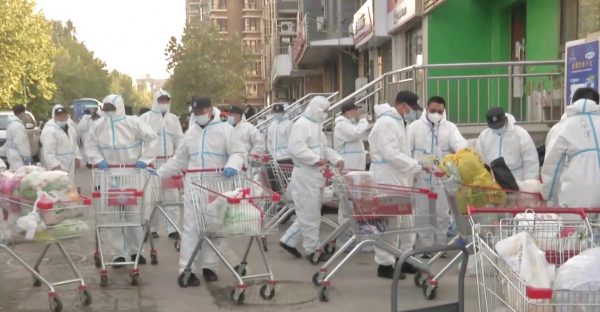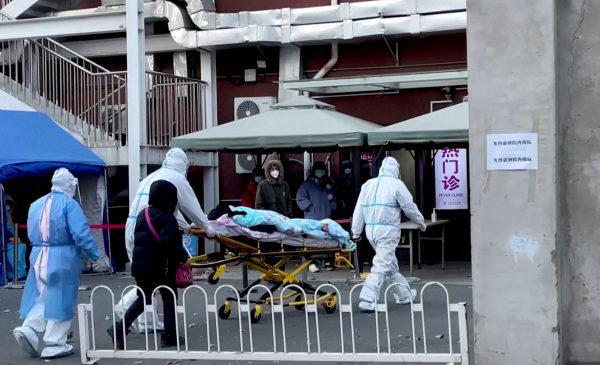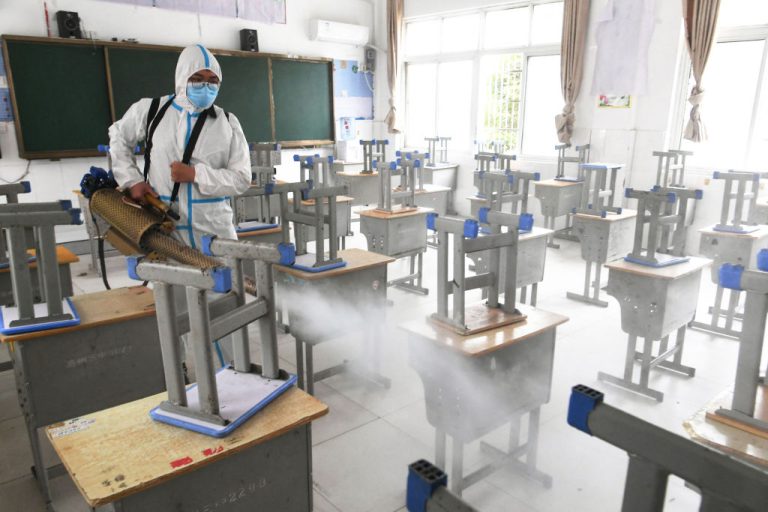In the last two years, while the world resumed activity and reopened borders as COVID-19 ran its course, China doubled down on its strict pandemic restrictions for nearly three years.
The “zero-COVID” controls — which ranged from disinfection theatrics, draconian lockdowns, mass testing, movement curbs, and travel restrictions — often resulted in entire districts or cities being locked down after just a handful of positive cases were detected.
Now, as China’s economy nosedives from its heavy-handed “zero-COVID” measures that shuttered businesses, halted supply chains, and led to skyrocketing unemployment, the world’s second largest economy finds itself struggling to jumpstart its economy and end virus restrictions as new COVID cases spike.
MORE ON CHINA’S ZERO-COVID MEASURES:
- How a Chinese Artist in Italy Became an Online Relay Point for Protests Against Communist ‘Zero-COVID’ Policy
- China Continues to Ease Out of ‘Zero-COVID’ Following Mass Protests
- As China’s Population Growth Stalls, So Will the Global Economy
- ‘We Don’t Want the Communist Party’: Chinese Rise Up Against ‘Zero-COVID’ Lockdowns
- China’s Guangzhou in Revolt Over Newest COVID Lockdown
The people rise up
Following mass protests that saw hundreds of thousands of people take to the streets to demand an end to the Chinese Communist Party’s (CCP) “zero-COVID” controls, China has reported its largest influx of new infections since the pandemic first began.
COVID-19 is the disease caused by SARS-CoV-2, the novel coronavirus that appeared sometime in late 2019 in the central Chinese city of Wuhan.
Success
You are now signed up for our newsletter
Success
Check your email to complete sign up
The CCP covered up the spread of the Wuhan virus for weeks before doing an about-face on Jan. 23, 2020, by which time the outbreak had become a global pandemic that would eventually kill millions.
Communist authorities ordered tight lockdowns of Wuhan and its surrounding province, leading to numerous incidents of brutality, mismanagement, supply shortages, and even deaths among those stuck in the quarantine zone.

Such outrages continued to occur and grew in number as local governments following Beijing’s orders to “resolutely” implement the zero-tolerance approach locked down much of the country repeatedly, often for weeks or months on end.
Popular unrest at the “zero-COVID” policy swelled, especially as even affluent metropolises like Xi’an, an ancient capital and major industrial center in the west; the cities of the Pearl River Delta in the southern Guangdong Province, home to tens of millions; or Shanghai — China’s largest city — were subject to the crushing epidemic control measures.
While the CCP announced “optimizations” to the policy after Xi Jinping took a third term as general secretary this October, the public had already had enough. That month and the next, hundreds of protests erupted throughout Chinese cities in two-thirds of the country’s provinces.
Protesters included tens of thousands of workers at the Foxconn iPhone factory in Zhengzhou as well as college students and staff in some of China’s most prestigious schools. They persisted over a week and thankfully ended without bloodshed.
Aftereffects
The Chinese demonstrations, which sometimes saw people call for the end of communist rule, may have hastened the Xi leadership’s plans to gradually abandon “zero-COVID,” since Beijing dropped the bulk of restrictions at the beginning of this month.
But with much of the Chinese population having had limited exposure to the outdoors since early 2020, COVID-19 infections and deaths are tearing through the country.
On Monday, Dec. 19, health authorities announced that two people had died from COVID-related complications in Beijing.
Though the deaths were the first to be officially reported since the dramatic easing of restrictions began on Dec. 7, widely circulated social media posts have pointed to a surge in demand at funeral homes, hospitals, and crematoriums in recent weeks — suggesting a much higher number of fatalities.
Since the CCP has been known to conceal or limit the release of accurate statistics, the number of actual deaths is predicted to be much higher. According to a funeral home located on the outskirts of the city, the number of new deaths were far more than they could handle.

“We are swamped with long queues for cremation, and [some customers] have had to wait until the next day to cremate their loved ones,” an employee told CNN under the condition of anonymity.
On Baidu — one of China’s top online search engines — searches for “funeral homes” by Beijing residents have hit a record high since the pandemic began in the central city of Wuhan in early 2020, CNN reported.
Experts warn that since people in China have not had a chance to build immunity and coexist with the virus, a wave of up to 1 million COVID-related deaths can be expected.
As the country abruptly ends its virus controls and abandons its “zero-COVID” approach, a nationwide reopening could result in up to 684 deaths per million people, according to a study conducted by three professors at the University of Hong Kong.
Given China’s population of 1.4 billion people, that would amount to 964,400 deaths, the study pointed out — adding that the simultaneous lifting of restrictions in all provinces would lead to hospitalization surges 1.5 to 2.5 times higher than what hospitals are equipped to handle.
The surge of infections would “likely overload many local health systems across the country,” the study, which was released on the Medrxiv preprint server on Dec. 14, said.
However, the November protests and other developments show that the Chinese people would much rather prefer their freedom than the unsustainable lockdowns.
In the Ba’nan district of Chongqing, residents were seen protesting at a quarantine site on Dec. 19 to demand that returning Chinese from abroad should only be isolated for two days in a facility, followed by three days of self-isolation. Currently, the policy calls for five days of mandatory quarantine, and 3 days of self-quarantine.
“Let us out!” The residents could be heard chanting in unison as droves of masked police officers lined the perimeters.
Is China running out of money?
Apart from Chinese society being unwilling to put up with movement restrictions and endless lines for frequent COVID tests, the Chinese economy may also be on its last legs given the ruin the Communist Party’s policies have brought to business.
As a major exporter of global goods, the restrictions have disrupted the flow of trade from China to other parts of the world. This has led to delays and shortages of certain products — bringing a ripple of negative impacts on businesses around the globe.
Though experts believe the rapid loosening of COVID restrictions may help “restore a semblance of normal social order and strengthen the economy to a degree,” it won’t solve the country’s long-term economic woes.
“The catering, travel and entertainment industries are likely to see big gains first, but they won’t lift the economy much,” Simone Gao, an expert on China affairs, and host of “Zooming In With Simone Gao,” wrote in a Dec. 20 op-ed published by the Wall Street Journal.
“Real estate — the backbone of China’s economy — might still struggle to recover,” Gao said.
Plagued by corruption and a lack of management, China’s real estate and banking sectors have faced a number of crises affecting millions of people.
Hoping to recoup some of the losses stemming from the lockdowns, struggling real estate developers have attempted to increase housing prices — resulting in a growing number of residents being unable to afford new properties, or opting to stop buying altogether.
In addition to the impact on global trade, China’s “zero-COVID” restrictions have also slowed economic growth and forced many businesses to abandon or massively downsize operations in the country. This has contributed to the global economic slowdown, as reduced demand for goods and services result in job losses — and a decline in consumer spending.
Leo Timm contributed to this report.














